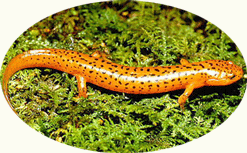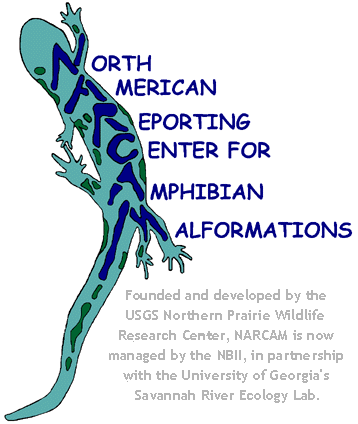- Home
- About S&T
- Taxa/Organisms
- Ecosystems
- Issues
- Methods & Tools
- Reports & Publications
- Location
- Search
Publisher: USGS | Science Center: Patuxent Wildlife Research Center (PWRC, Laurel) | Format: URL
igsaceeswb00.er.usgs.gov:8080 — From the Web site: "The Amphibian Research and Monitoring Initiative (ARMI) National Atlas for Amphibian Distributions (or simply, the ARMI Atlas), is a compilation of current and historic records of amphibian occurrences. These records are from published, peer-reviewed scientific literature, museum records, state and regional herpetological More...

Publisher: USGS | Format: URL
armi.usgs.gov — The U.S. Geological Survey's Amphibian Research and Monitoring Initiative (ARMI) is a multidisciplinary effort to determine the status and trends of amphibians in the U.S., research the causes for amphibian declines, and provide scientific information to decision-makers to help halt or reverse declines. This website includes information on ARMI's More...

Publisher: USGS | Science Center: Northern Prairie Wildlife Research Center (NPWRC, Jamestown) | Format: URL
www.npwrc.usgs.gov — Interest in amphibians continues to rise as people become more aware of this fascinating group of animals. To the uninitiated all frogs may look alike; ditto for salamanders (in the same manner that beginning birders are overwhelmed by the immense variety of small brown birds). One of the purposes of this checklist and online identification guide More...

Publisher: USGS | Science Center: Forest and Rangeland Ecosystem Science Center (FRESC, Corvallis) | Format: URL
fresc.usgs.gov — ARMI is an initiative of agencies within the United States Department of the Interior to measure, understand, and respond to effects of environmental change upon the Nation's amphibians. Amphibians have been disappearing from many locations around the world and reports of declines have increased in recent decades. Some of the most dramatic More...

Publisher: USGS | Science Center: National Wetlands Research Center (NWRC, Lafayette) | Format: URL
www.nwrc.usgs.gov — The south-central region includes the States of Texas, Oklahoma, Arkansas, Mississippi, and Louisiana. We are currently conducting research projects designed to monitor amphibians on Federal lands in these States and to research possible causes of declines in amphibian populations. These potential threats include loss or degradation of habitat, More...

Publisher: USGS | Science Center: Patuxent Wildlife Research Center (PWRC, Laurel) | Format: URL
www.pwrc.usgs.gov — An overview of research that addresses the issue of amphibian decline, assesses relationships between amphibian distribution and abundance and environmental factors in the parks, proposes standardized, long-term monitoring protocols, and evaluates and validates amphibian monitoring techniques at Shenandoah and Big Bend National Parks. The project More...

Publisher: USGS | Science Center: Fort Collins Science Center (FORT, Ft. Collins) | Format: URL
www.fort.usgs.gov — The Department of the Interior's Amphibian Research and Monitoring Initiative (ARMI) is designed to determine where populations of amphibians are present, to monitor specific apex populations, and to investigate potential causes of decline and deformity. The Rocky Mountain Region of ARMI encompasses Montana, Wyoming, Colorado, and New Mexico. Two More...

Publisher: USGS | Science Center: Florida Integrated Science Center (FISC, Gainesville) | Format: URL
fl.biology.usgs.gov — The objectives of Southeastern ARMI are to determine the status and trends of amphibian populations on DOI lands in the southeastern United States and U.S. Caribbean and to provide information useful in determining causes of declines should they be discovered. Meeting the needs and expectations of the Nation for monitoring the status of More...

Publisher: NBII | Format: URL
www.nbii.gov — NARCAM is a website reporting system for malformed amphibian malformations. The site is a portal of archives for malformed amphibian phenomena reports in the United States and Canada. Users can submit a Report to NARCAM, view malformations data, with access to maps of malformation occurrences. You can also learn more about the UV radiation, More...

Publisher: Center for Biological Informatics | Format: URL
www.frogweb.gov — Amphibian population declines are particularly serious in California, the Rocky Mountains, the Southwest, and Puerto Rico. This website addresses this concern by linking to resources about Amphibian Declines, Amphibian malformations, and resources to what can be done to help. There are additional links to species information and resources for More...

Publisher: USGS | Science Center: Upper Midwest Environmental Sciences Center (UMESC, LaCrosse) | Format: URL
www.umesc.usgs.gov — Constructed farm ponds represent significant breeding, rearing, and overwintering habitat for amphibians in the Driftless Area Ecoregion of southeastern Minnesota, western Wisconsin, and northeastern Iowa, a landscape where natural wetlands are scarce. Farm ponds are to prevent soil erosion and create wildlife habitat, yet no studies have been More...

Publisher: USGS | Science Center: Fort Collins Science Center (FORT, Ft. Collins) | Format: URL
www.fort.usgs.gov — At high elevations, and in the nearby Capitan and White mountains in alpine tundra habitat, the Sacramento Mountain salamander occurs. This issue overview looks at size-class distributions of salamanders, showing that juveniles comprise a significantly smaller proportion of all salamanders on logged plots, suggesting that populations on logged More...
